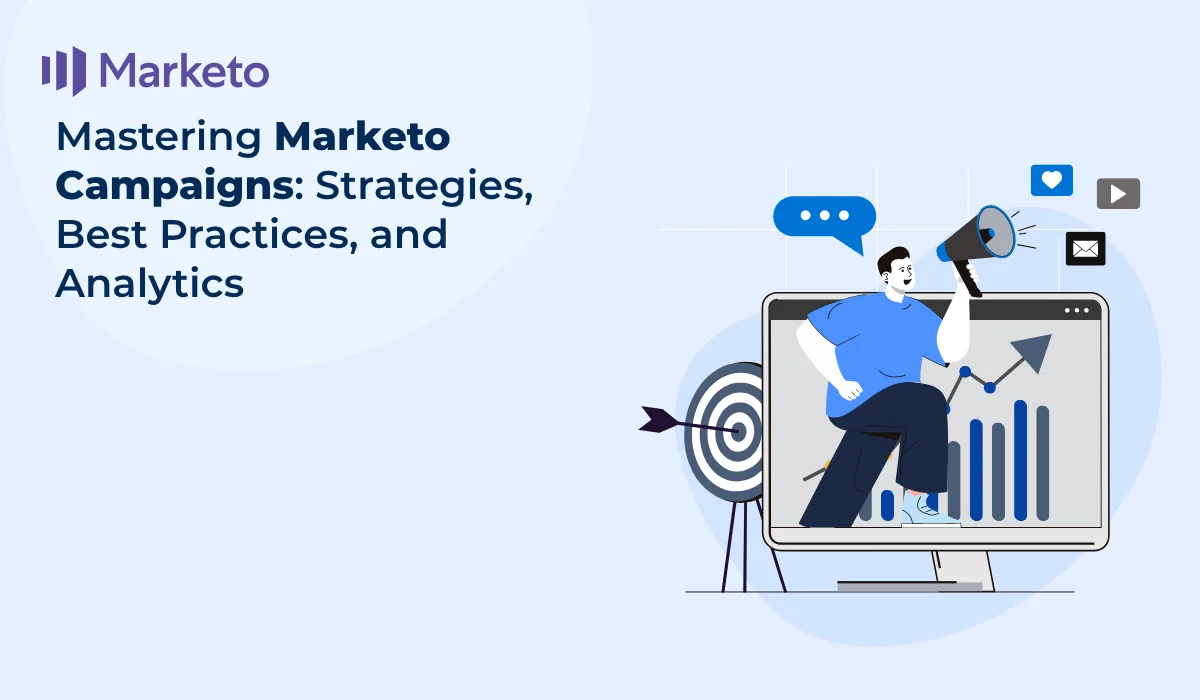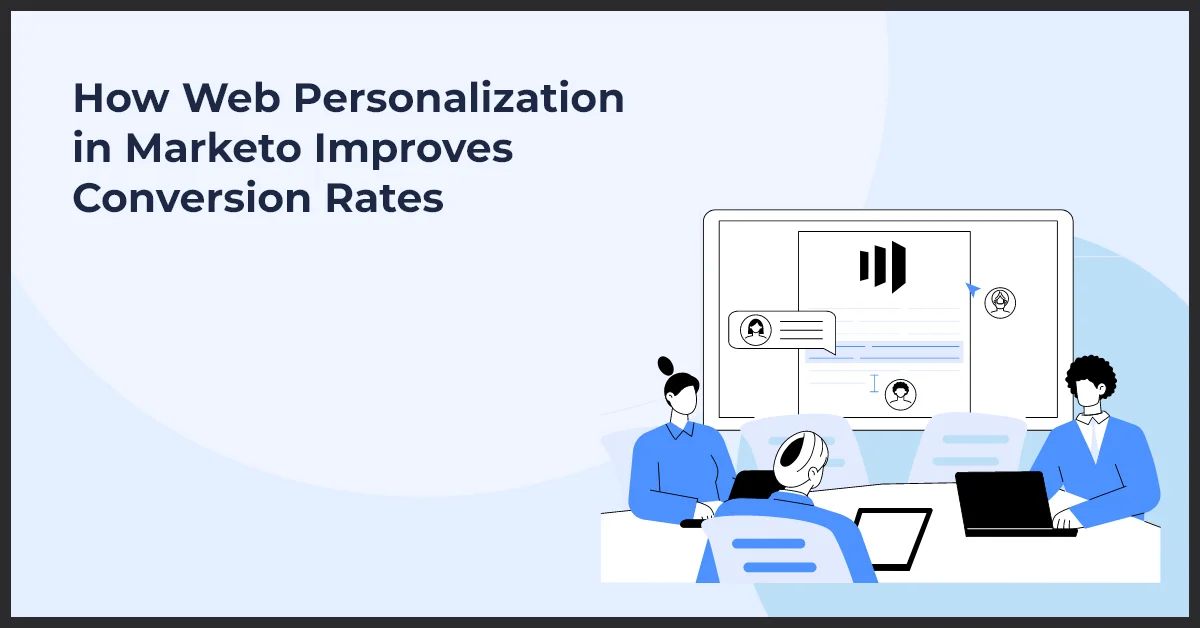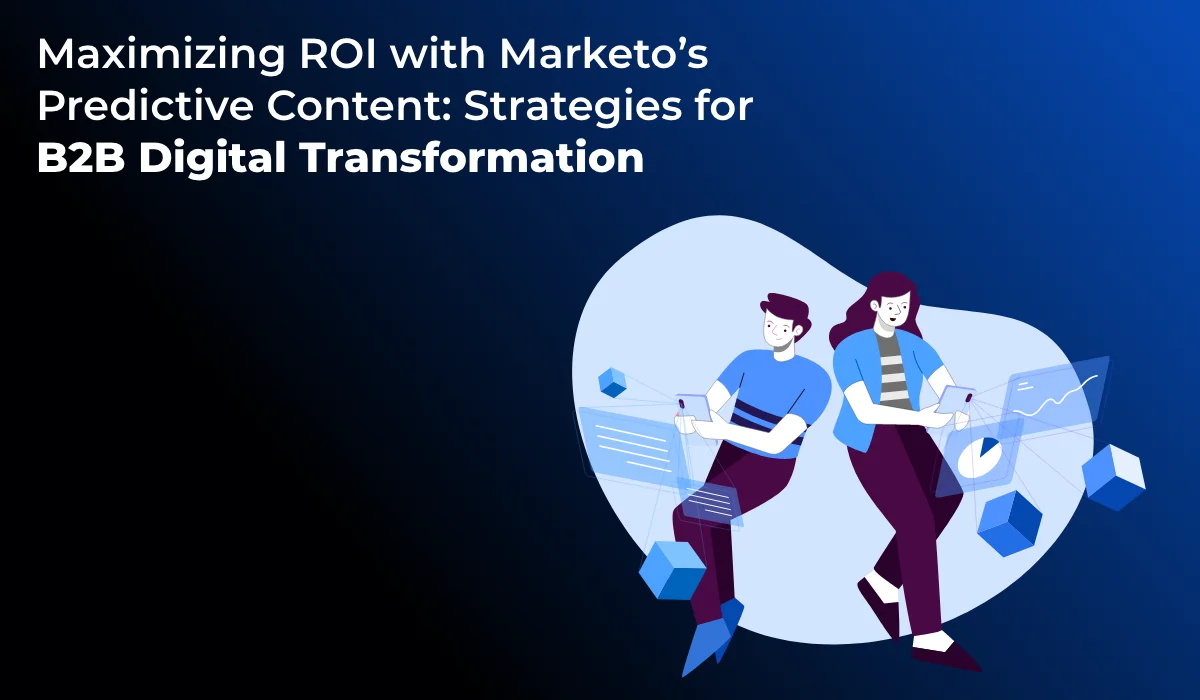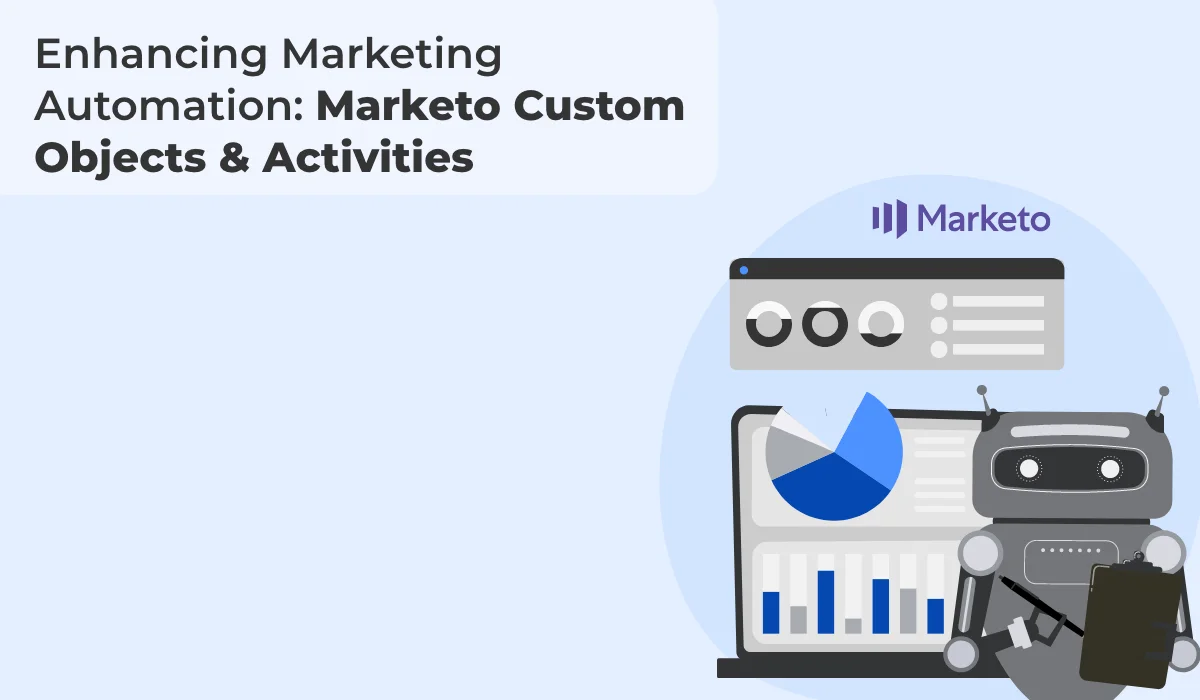Marketo Campaign Excellence: Proven Strategies, Analytics, and Best Practices

Published on: April 12, 2023
Updated on: February 28, 2025
3409 Views
- Marketo
16 min read
Marketo is a powerful marketing automation platform designed to help businesses grow and succeed in the digital age. This blog delves into the intricacies of Marketo campaigns, covering everything from setup to performance analysis. We'll explore Marketo best practices to enhance campaign effectiveness and drive better results. Whether you're new to Marketo or looking to refine your approach, this guide offers valuable insights for creating impactful campaigns.
Whether you're a seasoned Marketo user or just starting, this guide is your one-stop resource for mastering Marketo campaigns.
How can you master Marketo campaigns for better marketing results?
Mastering Marketo campaigns involves understanding your audience, establishing consistent naming conventions, leveraging automation, and tracking performance metrics. Key strategies include using personalized content, A/B testing, and optimizing campaigns for mobile. Additionally, focusing on lead scoring, nurturing, and consistent branding helps improve engagement and conversions. Regular analysis of campaign performance ensures data-driven optimization and improved ROI. Implementing these practices will help you maximize the impact of your Marketo campaigns.
Mastering Marketo: 5 Best Practices to Elevate Your Marketing Game
When it comes to using Marketo, there are a few best practices that can help you get the most out of this powerful marketing automation software. Whether you're a beginner just starting out or an experienced user looking for ways to improve your campaigns, these tips can help you optimize your marketing efforts and achieve better results.
1. Understand Your Audience Inside Out
First and foremost, it's important to have a clear understanding of your target audience and their needs. By knowing who you're trying to reach, you can tailor your messaging and campaigns to resonate with them. This means creating buyer personas and segmenting your audience accordingly. By doing this, you can send personalized and relevant content that will capture their attention and drive engagement.
2. Embrace Consistent Naming Conventions
Another best practice is to establish a consistent naming convention for your Marketo programs, campaigns, and assets. This will make it easier for you and your team to locate and organize your marketing materials. It's also a good idea to create naming conventions for your fields, email templates, and other assets within Marketo. Consistency and organization are key when it comes to managing your marketing efforts efficiently.
3. Harness the Power of Automation
Automation is a major benefit of using Marketo, and taking advantage of this feature can save you time and effort. Use Marketo automation capabilities to set up triggers, workflows, and email nurtures that can automatically respond to customer behaviors and actions. This will help you nurture leads and move them through the sales funnel more effectively.
4. Track, Measure, and Optimize
Tracking and measuring the success of your campaigns is crucial to understanding what's working and what needs improvement. Marketo provides robust analytics and reporting features that allow you to track key metrics and measure the performance of your campaigns. Use these insights to make data-driven decisions and optimize your marketing strategies.
5. Never Stop Learning and Adapting
Lastly, ongoing education and staying up to date with the latest Marketo features and best practices is vital. Marketo offers various resources, including online training courses and a community of users, where you can learn from experts and other marketers. By staying informed and continuously improving your skills, you can maximize the potential of Marketo and achieve your marketing goals.
Implementing these best practices can help you unleash the full potential of Marketo and drive meaningful results for your business. Remember, it's not just about the technology, but how you use it. So take the time to understand your audience, organize your campaigns, automate your processes, track your performance, and keep learning. Your success with Marketo depends on it.
Understanding Marketo Campaign Types
Let's dive deeper into the different types of Marketo campaigns to help you better understand their purpose and use cases:
Email Campaigns:
Email campaigns are the backbone of most marketing automation strategies. They involve sending targeted, personalized emails to your audience to achieve a specific objective, such as nurturing leads, promoting content, or making announcements.
Here are some common types of email campaigns in Marketo:
- Drip Campaigns: Drip campaigns send pre-written emails to leads at specific intervals, keeping them engaged over time. They are ideal for nurturing leads, onboarding new customers, or providing educational content.
- Triggered Campaigns: Triggered campaigns begin when an event or action, such as a lead filling out a form, clicking a link in an email, or visiting a specific web page, occurs. These campaigns enable real-time, personalized engagement based on user behavior.
- Newsletters: Newsletters are periodic emails informing your audience about your company's latest news, product updates, or content pieces. They help maintain regular communication with your audience and build brand loyalty.
Event Campaigns:
Event campaigns promote, manage, and analyze events. These campaigns streamline the event management process, from registration to post-event follow-up.
They can include:
- Webinar Campaigns: Webinar campaigns involve promoting and managing online webinars, including sending invitations, handling registrations, and sending post-webinar follow-up emails.
- Live Event Campaigns: Live event campaigns manage in-person events like tradeshows, workshops, or seminars, including promoting the event, managing registrations, and post-event communications.
- Hybrid Event Campaigns: Hybrid event campaigns combine elements of in-person and online events, enabling you to cater to a broader audience and provide a flexible experience for attendees.
Nurture Campaigns:
Nurture campaigns aim to engage and guide leads through the sales funnel by providing timely, relevant content based on their position in the buyer's journey.
They can include:
- Welcome Campaigns: Welcome campaigns introduce new leads to your company and set the stage for future communications, providing critical information and resources to help them get started.
- Top-of-Funnel Campaigns: Top-of-funnel campaigns target leads in the awareness stage, providing educational content to help them identify their challenges and potential solutions.
- Middle-of-Funnel Campaigns: Middle-of-funnel campaigns target leads in the consideration stage, showcasing your product or service's unique value proposition and differentiators to persuade them to choose your offering.
- Bottom-of-Funnel Campaigns: Bottom-of-funnel campaigns target leads in the decision stage, providing case studies, testimonials, or personalized demos to help them decide.
Account-Based Marketing (ABM) Campaigns:
ABM campaigns focus on engaging high-value accounts with personalized, targeted marketing efforts to generate revenue. These campaigns often involve collaboration between marketing and sales teams to identify key accounts, develop targeted content, and execute a strategic approach.
Common types of ABM campaigns include:
- Target Account Campaigns: Target account campaigns focus on engaging a specific set of high-value accounts by delivering personalized content, messaging, and offers tailored to their unique needs and pain points.
- Industry-Specific Campaigns: Industry-specific campaigns target high-value accounts within a particular industry, using tailored content and messaging that addresses these companies' unique challenges and opportunities.
- Role-Based Campaigns: Role-based campaigns target decision-makers within high-value accounts based on their job roles and responsibilities, providing content and messaging that
Setting Up Your Marketo Campaign
Following these guidelines can create an effective and efficient marketing campaign that meets your objectives.
One: Preparing for Your Marketo Campaign
- a. Defining Campaign Objectives and KPIs:
Before you begin setting up your Marketo campaign, defining your campaign objectives and key performance indicators (KPIs) is crucial. These will help you measure your campaign's success and inform your strategy. Goals include increasing brand awareness, generating leads, or driving conversions, while KPIs could consist of metrics like click-through rates, conversion rates, or generated revenue.
- b. Understanding Marketo Campaign Types:
Review the different Marketo campaign types (Email, Event, Nurture, and ABM) and determine which type best aligns with your campaign objectives.
- c. Organizing Marketing Activities and Folders:
Create a folder structure in Marketo's Marketing Activities section to organize your campaigns. Group similar drives together and use descriptive folder names for easy navigation.
Two: Creating and Configuring Your Marketo Campaign
- 2. a. Creating a New Program:
In the Marketing Activities section, click "New" and select the appropriate program type (e.g., Email, Event, Nurture, or ABM) based on your campaign objectives.
- 2. b. Defining Your Target Audience:
Create a Smart List in Marketo to define your target audience using filters and segmentation rules based on criteria like demographics, behaviors, or lead scores.
- 2. c. Designing and Creating Campaign Assets:
Design and create the necessary campaign assets, such as emails, landing pages, and forms. Use Marketo's Email Editor and Landing Page Builder to create visually engaging and responsive assets.
- 2. d. Setting Up Campaign Flows:
In the Flow tab of your program, set up the sequence of actions, triggers, and filters that define your campaign's logic. This includes sending emails, changing lead scores, or updating data values based on specific criteria or actions taken by your leads.
- 2. e. Scheduling and Launching Your Campaign:
In the Schedule tab, set your campaign's start date and time, or click "Run Once" to launch it immediately. Ensure all assets and flows are thoroughly reviewed and tested before scheduling.
Three: Testing and Optimizing Your Marketo Campaign
- 3. a. A/B Testing:
Conduct A/B tests on your campaign assets, such as subject lines, email copy, or landing page designs, to identify the most effective versions. Use Marketo's A/B testing feature to set up and analyze your tests.
- 3. b. Lead Scoring and Nurturing:
Implement lead scoring to prioritize and nurture high-quality leads. Use Marketo's Lead Scoring feature to assign scores based on lead behavior, demographic data, or other criteria. Develop nurture campaigns to engage and guide leads through the sales funnel.
- 3. c. Mobile Optimization and Responsive Design:
Ensure your emails, landing pages, and forms are optimized for mobile devices. Use Marketo's responsive design features to create assets that adapt to various screen sizes and devices.
Four: Tracking and Analyzing Your Marketo Campaign Performance
- 4. a. Email Insights and Metrics:
Track the performance of your email campaigns by monitoring key metrics such as open rate, click-through rate, and conversion rate. Use Marketo's Email Insights to access detailed reports and analyze your email performance.
- 4. b. Program Performance Reports:
Evaluate the overall success of your campaign by reviewing program performance reports in Marketo. These reports provide insights into metrics like leads generated, revenue, and return on investment (ROI).
- 4. c. Attribution Reports and Web Analytics:
Use Marketo's attribution reporting tools to understand the impact of your marketing efforts on revenue generation. Analyze multi-touch attribution models to determine which channels and touchpoints contribute the most to your success. Additionally, leverage Marketo's web analytics features to track the performance of your landing pages and forms, identifying areas for improvement.
Best Practices for Marketo Campaigns
Best practices are essential for maximizing the effectiveness and success of your Marketo campaigns. By implementing these practices, you can optimize your campaigns to deliver better results and drive a higher return on investment (ROI).
Here are some critical best practices for Marketo campaigns:
Personalization:
Personalize your content and communications to make them more engaging and relevant to your audience. Use Marketo's personalization features, such as dynamic content and tokens, to customize email subject lines, body content, and landing pages based on the recipient's information or behavior.
A/B Testing:
Test different versions of your assets to determine which one performs best. Marketo's A/B testing features allow you to test variations of emails, subject lines, landing pages, and other assets. Analyze the results to identify the most effective elements and continuously apply these learnings to improve your campaigns.
Lead Scoring:
Implement lead scoring to prioritize and nurture high-quality leads. Marketo's Lead Scoring feature enables you to assign scores to leads based on their behavior, demographic data, or other criteria. You can allocate resources more effectively and improve conversion rates by focusing on high-scoring leads.
Lead Nurturing:
Develop nurture campaigns to engage and guide leads through the sales funnel. Use Marketo's Engagement Programs to create targeted, automated email campaigns that provide timely and relevant content based on a lead's position in the buyer's journey. This helps build stronger relationships and moves leads closer to conversion.
Mobile Optimization:
Optimize your content for mobile devices to cater to the growing number of mobile users. Ensure your emails, landing pages, and forms are designed using responsive templates and are easily viewable on various screen sizes and devices.
Segmentation:
Segment your audience based on specific criteria such as demographics, behaviors, or interests. Marketo's Smart Lists allow you to create highly targeted segments to deliver more relevant and engaging content, resulting in better engagement and conversion rates.
Consistent Branding:
Maintain consistent branding across all your campaign assets to create a cohesive and professional look. This includes using the same color schemes, fonts, and imagery in your emails, landing pages, and other marketing materials. Consistent branding helps build brand recognition and trust among your audience.
GDPR Compliance:
Ensure that your campaigns adhere to GDPR regulations and best practices. This consists of obtaining explicit consent from leads before sending them marketing communications, providing clear opt-out options in your emails, and securely managing and storing personal data.
Analyze and Optimize:
Continuously analyze your campaign performance data to identify areas for improvement. Use Marketo's reporting and analytics tools to track key metrics, such as open rates, click-through rates, and conversion rates. Apply insights from this analysis to optimize your campaigns and drive better results.
Collaboration:
Encourage collaboration between marketing, sales, and other departments to ensure a cohesive and effective campaign strategy. Share insights and best practices, align on objectives, and coordinate efforts to improve campaign performance and achieve desired outcomes.
By implementing these best practices, you can optimize your Marketo campaigns to drive higher engagement, conversions, and overall success. Remember to continuously iterate and learn from your campaigns to stay ahead of the competition and deliver the best possible results.
Analyzing Your Marketo Campaign Performance
Analyzing your Marketo campaign performance is crucial for understanding the effectiveness of your marketing efforts, identifying areas for improvement, and optimizing future campaigns.
Here are some key steps and tools you can use to analyze your Marketo campaign performance:
Email Insights and Metrics:
Track the performance of your email campaigns by monitoring key metrics such as open rate, click-through rate, bounce rate, and conversion rate. Marketo's Email Insights tool provides detailed reports that help you analyze the performance of individual emails and overall campaign success. Use these insights to refine your email content, subject lines, and send times.
Program Performance Reports:
Evaluate the overall success of your campaigns by creating program performance reports in Marketo. These reports provide insights into metrics like leads generated, revenue, return on investment (ROI), and cost per lead. By comparing program performance across different campaigns, you can identify trends, patterns, and areas for improvement.
Marketo Attribution
Marketo Attribution is a powerful tool that allows you to understand the impact of your marketing efforts across different channels. With Marketo Attribution, you can track and measure the effectiveness of your campaigns, from email marketing to social media advertising.
One of the biggest challenges in marketing is knowing which of your efforts are driving the most results. With Marketo Attribution, you can finally get a clear picture of where your leads and conversions are coming from. By tracking every touchpoint along the customer journey, you can see which channels are performing the best and make data-driven decisions to optimize your marketing strategy.
But Marketo Attribution is more than just a tracking tool. It also provides valuable insights into the customer experience. By understanding the different touchpoints that lead to a conversion, you can create personalized and targeted campaigns that resonate with your audience. You can identify potential bottlenecks in the customer journey and make improvements to increase conversion rates.
Whether you're a small business or a large enterprise, Marketo Attribution can help you make sense of your marketing data. With its easy-to-use interface and powerful reporting capabilities, you can uncover hidden opportunities and take your marketing efforts to the next level.
So, if you're ready to take control of your marketing analytics and truly understand the impact of your campaigns, give Marketo Attribution a try. It's time to make your marketing efforts count and drive real results for your business.
Landing Page and Form Analytics:
Track the performance of your landing pages and forms using Marketo's web analytics features. Monitor key metrics like page views, conversions, and conversion rate to assess the effectiveness of your landing page designs, copy, and calls-to-action. Use these insights to optimize your landing pages for better engagement and conversions.
Lead Scoring Analysis:
Analyze your lead scoring model to ensure it accurately reflects lead quality and prioritizes high-value leads. Review the criteria for assigning lead scores, and adjust them as needed to align with your business objectives. Regularly monitor the distribution of lead scores across your database to ensure your scoring model is working effectively.
Engagement Program Performance:
Evaluate the success of your nurture campaigns by reviewing engagement program performance metrics such as engagement score, cast success, and email performance. Use these insights to identify high-performing nurture streams, improve content relevance, and optimize the cadence and timing of your nurture campaigns.
A/B Testing Analysis:
Review the results of your A/B tests to identify the most effective versions of your campaign assets. Use Marketo's A/B testing features to compare the performance of different subject lines, email copy, or landing page designs. Apply the learnings from these tests to continuously refine and optimize your campaigns.
Custom Reports and Dashboards:
Create custom reports and dashboards in Marketo to monitor the performance metrics that matter most to your business. By tailoring your reports and dashboards to your unique needs, you can gain deeper insights into your campaigns' success and make data-driven optimization decisions.
Benchmarking:
Compare your campaign performance against industry benchmarks to understand how your efforts stack up against your competitors. Use third-party benchmarking data or Marketo's benchmarking reports to assess your performance in key areas such as email engagement, conversion rates, and ROI.
By regularly analyzing your Marketo campaign performance using these tools and techniques, you can identify areas for improvement, make data-driven decisions, and optimize your marketing efforts for better results. Remember to continuously iterate and learn from your campaigns to stay ahead of the competition and deliver the best possible outcomes for your business.
Conclusion
Marketo campaigns can be incredibly effective when executed properly. By understanding the different campaign types, setting up your campaign strategically, following best practices, and analyzing performance data, you can maximize the impact of your marketing efforts. With Marketo, the possibilities are endless – so get started on your next campaign and watch your business grow!
You're in the right place if you are looking for Marketo campaigns for successful implementation. Email us at info@growthnatives.com to contact our Marketo experts, or call our toll-free number +1 855-693-4769 to supercharge your marketing campaigns.
Frequently Asked Questions
Mastering Marketo campaigns is crucial for maximizing marketing ROI, improving lead generation, nurturing leads effectively, and optimizing customer engagement through data-driven strategies.
To create a Marketo campaign, you start by defining your campaign goals, setting up smart campaigns with triggers and actions, designing related emails and landing pages, and configuring workflows to automate responses.
Smart campaigns in Marketo are automated workflows that trigger actions based on predefined rules, such as sending emails, updating lead status, or assigning tasks to sales representatives.
Marketo campaigns can improve lead generation by capturing leads through optimized landing pages and forms, nurturing them with targeted content, and scoring leads based on their engagement.
Advanced features include predictive analytics, AI-driven content recommendations, account-based marketing (ABM), multi-touch attribution modeling, and personalized customer journeys.
A/B testing in Marketo involves testing variations of emails, landing pages, and CTAs to determine which performs better in terms of engagement and conversion rates, optimizing campaign effectiveness.



